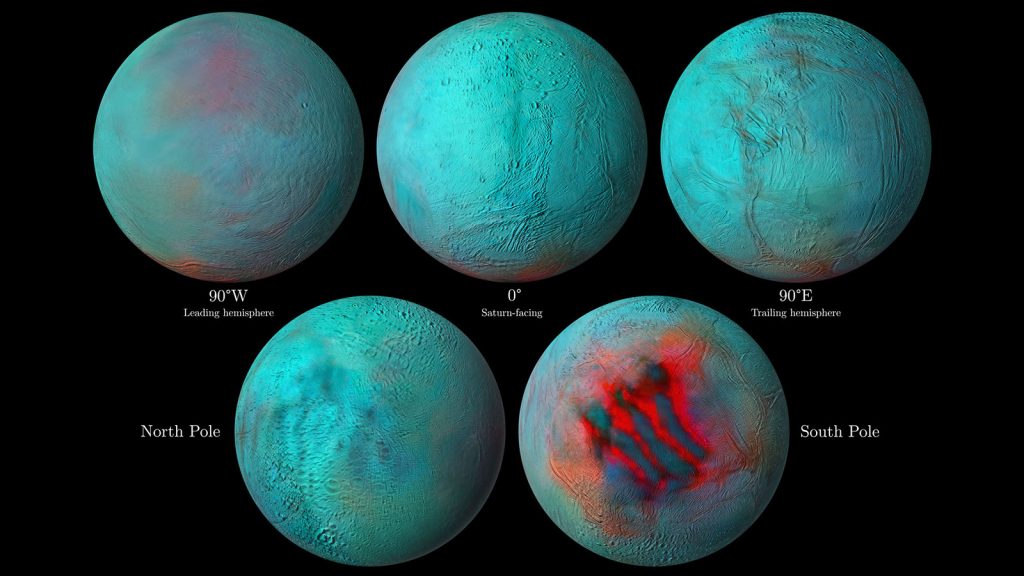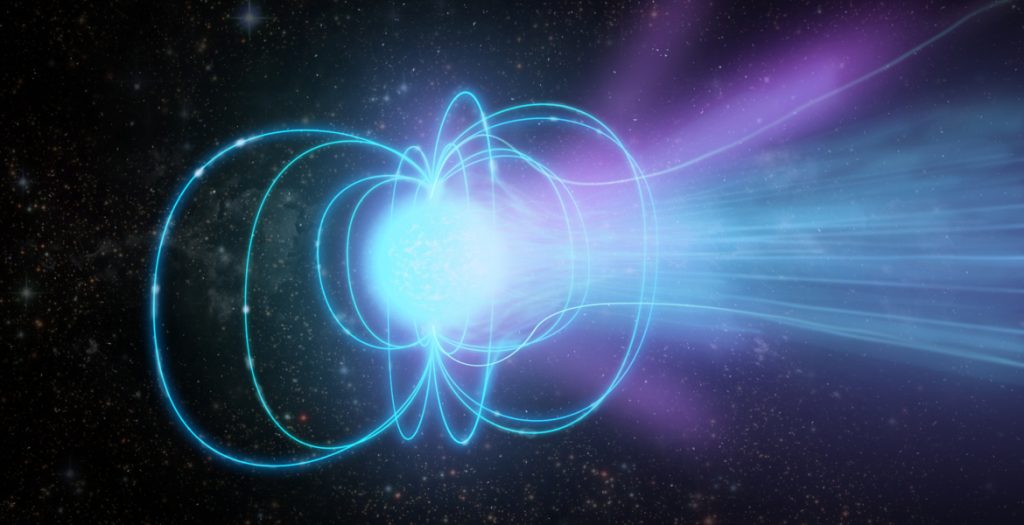Media
Transcript
After last week’s constant thrum of new and exciting news, I’m somewhat relieved to say this particular Monday is a rather slow news day. We expect things to change as the week goes on. The virtual Europlanet Science Conference starts today, and this meeting typically brings us some awesome planetary science news.
In fact, today’s news starts with new information about Enceladus that is brought to us through a careful analysis of NASA’s Cassini spacecraft data. Just like some people will wait for a TV series to conclude before they binge-watch, some scientists will wait for a mission to end before they binge making global mosaics.
In a new paper appearing in the journal Icarus, a research team led by Rozenn Robidel releases stunning composite images of Saturn’s moon Enceladus that show Infrared heatmaps superimposed on detailed maps. Using your standard red is warm, blue is cool false color mapping of temperature, these composites unremarkably show the heat and fresh ice associated with the tiger stripes found along Enceladus’ south pole. What wasn’t expected are the warmer regions found in the northern hemisphere and hints that fresh ice also lays on that surface.

These findings are consistent with a paper we discussed back in December of 2019. According to work published in Nature by lead author Doug Hemingway and company, the ice at Enceladus’ poles is thinner than at the equator. With Enceladus, as it orbits, it regularly changes its distance from Saturn, and this causes distortions that also drive heating and cooling. As it cools, ice expands. At some point, as the ice expanded, something had to give and they postulated that random chance is why we see the south pole as cracked. These new infrared measurements seem to indicate that while the big activity occurred in the south, the northern hemisphere has also been covered in thin ice that sometimes gets resurfaced through rising materials.
Jumping from nearby moons to far out problem stars, our next story looks at a neutron star with an extreme magnetic field that is located some 8,100 light-years away. Cataloged as XTE J1810-197, this tiny object regularly pulsed in the radio from 2003-2008. Then it stopped for ten years, only to begin pulsing again in December 2018. Since its reawakening, this system has been regularly observed by a global network of radio telescopes through the Very Long Baseline Array (VLBA). This includes observations from January to November 2019, and then roughly 6 months later, in March and April of 2020.
The discovery of magnetars is relatively recent, and there are still a lot of unknowns about their physics. We know, thanks to an outburst in December 2004, that these objects can release so much energy that a magnetar on the other side of our galaxy can damage satellites here at Earth.

When fast radio bursts (FRBs) were discovered in 2007, magnetars seemed to be a reasonable possible source of these millisecond bursts of energy, and on April 28 of this year, one magnetar, SGR 1935+2154 even emitted a brief radio burst that, while not as strong as a fast radio burst, was consistent enough with their behavior to make everyone take notice. One issue, however, has been that without actual distances to magnetars, we can only estimate the true luminosity of their outbursts.
This is where those high-resolution, six-months apart VLBA observations become important. The Earth’s change in location allows astronomers to measure the apparent change in position of XTE J1810-197 relative to background objects like quasars, and this gets a distance. According to Hao Ding, the first author on a new paper in Monthly Notices of the Royal Astronomical Society (MNRAS): This is the first parallax measurement for a magnetar, and shows that it is among the closest magnetars known — at about 8,100 light-years — making it a prime target for future study.
Coauthor Adam Deller goes on to state: Having a precise distance to this magnetar means that we can accurately calculate the strength of the radio pulses coming from it. If it emits something similar to an FRB, we will know how strong that pulse is. FRBs vary in their strength, so we would like to know if a magnetar pulse comes close or overlaps with the strength of known FRBs.
This is only one magnetar, and it is only a starting point. More distances will need to be determined, so there is a greater chance that we’ll catch something bursting that we know the distance to.
If we don’t try and look for things, we can’t find them. In the most unusual to me case of data randomly showing something unexpected, analysis of ultraviolet data from ESA’s Rosetta mission’s 2014-2016 encounter with Comet 67P/Churyumov-Gerasimenko shows evidence of the comet having aurorae. According to Southwest Research Institute’s Jim Burch: Charged particles from the Sun streaming towards the comet in the solar wind interact with the gas surrounding the comet’s icy, dusty nucleus and create the auroras.

Researcher Joel Parker goes on to state: Initially, we thought the ultraviolet emissions at comet 67P were phenomena known as ‘dayglow,’ a process caused by solar photons interacting with cometary gas. We were amazed to discover that the UV emissions are aurora, driven not by photons, but by electrons in the solar wind that break apart water and other molecules in the coma and have been accelerated in the comet’s nearby environment. The resulting excited atoms make this distinctive light.
This new work appears in Nature Astronomy and was led by Marina Galand.
And that rounds out the news for today. Before we go, I’d like to let you know about two events coming up. This Saturday is International Observe the Moon Night, and we will be streaming a many-hours celebration starting at 5:30 pm Eastern on Twitch.tv/CosmoQuestX. Join us to get science, observations, lunar art, and opportunities to have your questions answered by lunar scientists. We recognize this event conflicts with Yom Kippur and will make recordings of the event available online.
In a month, on October 24-25. We’ll be hosting a Hangoutathon. Our goal is to raise $36k by the end of those 36 hours. This means you’re welcome to start donating now! This amount is needed to get us through the fiscal year 2021 and represents the difference between what we typically bring in each month and what is needed to pay all our bills. Please give if you can and save the date no matter what. This should be a wild weekend of science, a Minecraft scale solar system build, and guests, and giveaways. Learn more, and donate today at Cosmoquest.org.
Learn More
Hints of Fresh Ice in Enceladus’s Northern Hemisphere
- NASA Jet Propulsion Laboratory press release
- “Photometrically Corrected Global Infrared Mosaics of Enceladus: New Implications for Its Spectral Diversity and Geological Activity,” R. Robidel et al., 2020 October, Icarus
VLBA Makes First Direct Distance Measurement to Magnetar
- NRAO press release
- “A Magnetar Parallax,” H. Ding et al., 2020 Aug. 21, Monthly Notices of the Royal Astronomical Society (preprint on arxiv.org)
Unexpected Ultraviolet Aurora Detected at a Comet
- SwRI press release
- NASA JPL press release
- University of Bern press release
- “Far-ultraviolet aurora identified at comet 67P/Churyumov-Gerasimenko,” M. Galand et al., 2020 Sep. 21, Nature Astronomy
Credits
Written by Pamela Gay
Hosted by Pamela Gay
Audio and Video Editing by Ally Pelphrey
Content Editing by Beth Johnson
Intro and Outro music by Kevin MacLeod, https://incompetech.com/music/


 We record most shows live, on Twitch. Follow us today to get alerts when we go live.
We record most shows live, on Twitch. Follow us today to get alerts when we go live.